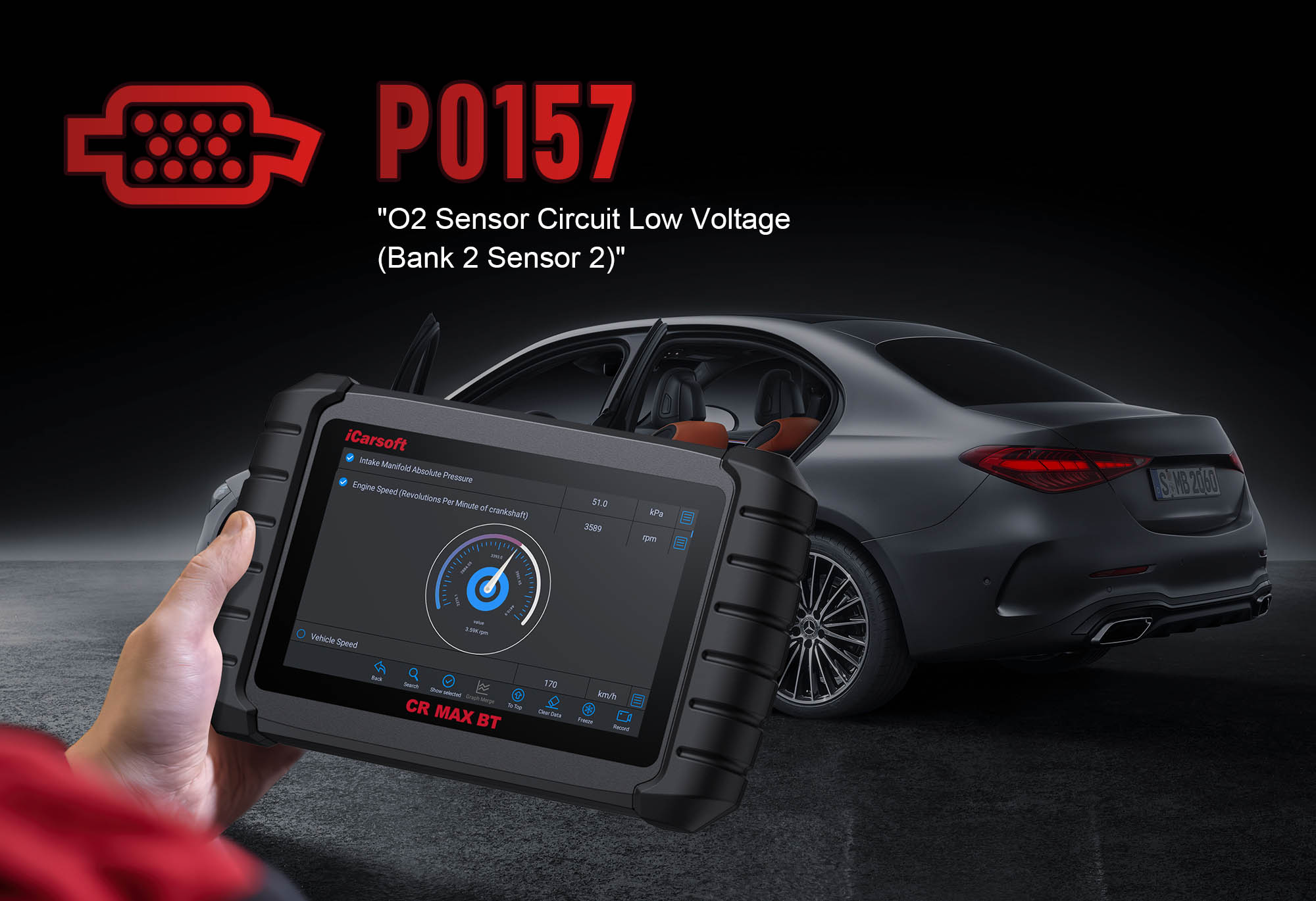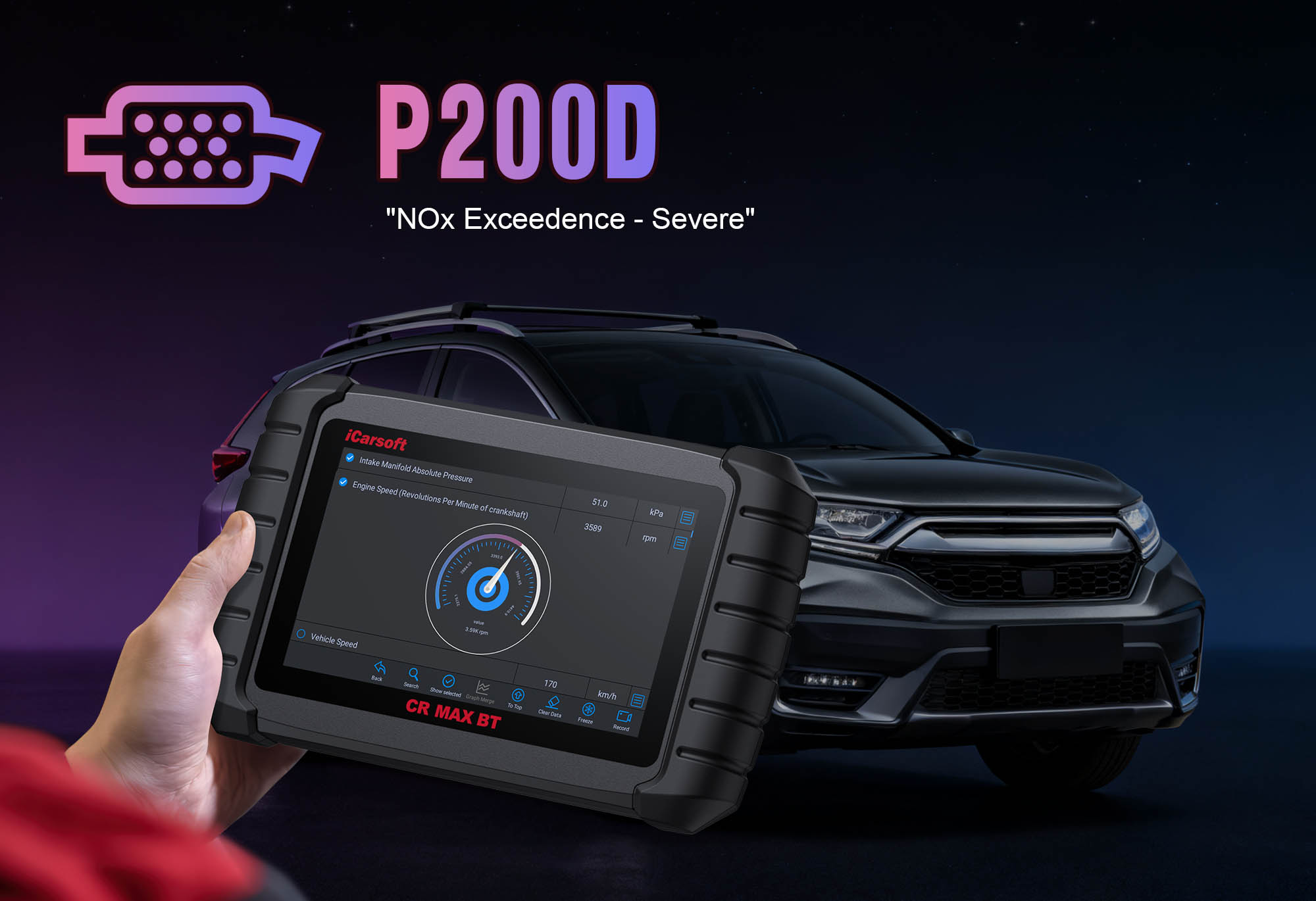Diagnose & Clear P0157 with iCarsoft CR MAX BT: Fix O2 Sensor Circuit Low Voltage (Bank 2, Sensor 2)
If your check engine light illuminates and a scan returns P0157, your vehicle’s emissions system is signaling a problem with the downstream oxygen sensor in Bank 2. This OBD-II code stands for "Oxygen Sensor Circuit Low Voltage (Bank 2, Sensor 2)"—indicating the Engine Control Module (ECM) is receiving an abnormally low voltage signal (consistently below 0.1V) from the downstream oxygen sensor, which monitors exhaust gases after they pass through the catalytic converter.
Downstream O2 sensors play a critical role in verifying catalytic converter efficiency. Unlike upstream sensors (which adjust fuel mixture), healthy downstream sensors produce a stable voltage around 0.45V once the converter is operating properly. When P0157 occurs, Bank 2’s downstream sensor sends a persistently low voltage, signaling issues like a faulty sensor, damaged wiring, exhaust leaks, or a failing catalytic converter. This can lead to failed emissions tests, reduced fuel efficiency, and hidden engine performance problems.
Basic scanners may only flag "O2 sensor low voltage" but lack the ability to analyze signal stability or compare upstream/downstream readings. The iCarsoft CR MAX BT—with its wireless waveform analysis, real-time voltage monitoring, and converter efficiency tests—solves this. Let’s explore how to diagnose and resolve P0157 using this advanced tool.
 iCarsoft CR MAX BT displaying Bank 2 upstream/downstream O2 voltage and catalytic converter efficiency data for P0157 diagnosis
iCarsoft CR MAX BT displaying Bank 2 upstream/downstream O2 voltage and catalytic converter efficiency data for P0157 diagnosis
Understanding P0157: Causes & Key Symptoms
A P0157 code indicates a disruption in the downstream O2 sensor signal, leading to specific performance and system issues:
Key Symptoms of P0157
-
Check Engine Light: Illuminates when Bank 2, Sensor 2 voltage remains below 0.1V for 3+ consecutive minutes of driving.
-
Failed Emissions Tests: Inability to monitor converter performance leads to high hydrocarbon (HC) or carbon monoxide (CO) levels.
-
Reduced Fuel Efficiency: The ECM may misadjust fuel delivery based on faulty sensor data, lowering MPG by 5–10%.
-
Catalytic Converter Warning: Persistently low voltage can signal a failing converter or exhaust leaks before the sensor.
-
Intermittent Rough Idle: In some vehicles, downstream sensor faults can indirectly affect upstream adjustments, causing minor combustion issues.
Common Causes of P0157
|
Cause
|
Description
|
|
Faulty Downstream O2 Sensor (Bank 2, Sensor 2)
|
Internal electrical failure (open sensing element or damaged wiring) causes stuck low voltage—accounts for ~45% of P0157 cases.
|
|
Exhaust Leaks
|
Leaks before the downstream sensor draw in excess oxygen, driving voltage down to near 0V—common in older vehicles with rusted exhaust systems.
|
|
Wiring Issues
|
Damaged, disconnected, or corroded wires in the sensor circuit interrupt voltage transmission—worsened by undercarriage exposure to debris.
|
|
Corroded Connector
|
Moisture or rust in the sensor plug creates high resistance, dropping voltage below the ECM’s threshold.
|
|
Failed Catalytic Converter
|
A non-functional converter may allow oxygen-rich exhaust to reach the sensor, though this more commonly triggers high voltage codes (e.g., P0138).
|
|
ECM Malfunction (Rare)
|
A faulty ECM misinterprets normal sensor data as "low," usually paired with other electrical codes (e.g., P0606).
|
Why iCarsoft CR MAX BT Excels at Diagnosing P0157
The CR MAX BT outperforms basic tools with features tailored to downstream O2 sensor diagnostics:
Wireless Waveform Analysis
Streams real-time voltage patterns from Bank 2, Sensor 2 to your device, identifying if the signal is truly stuck low (flat line <0.1V) or intermittently dropping.
Upstream vs. Downstream Comparison
Side-by-side data for Bank 2’s upstream (Sensor 1) and downstream (Sensor 2) sensors highlights discrepancies (e.g., upstream fluctuates normally, downstream stays flat).
Catalytic Converter Efficiency Test
Calculates converter performance by comparing upstream/downstream readings to rule out converter failure as a root cause.
Vehicle-Specific Diagrams
Preloaded 3D schematics show Bank 2 layout, downstream sensor location (after converter), and wiring paths for 80+ makes (Hyundai, Dodge, Subaru, Mercedes-Benz).
Circuit Continuity & Resistance Testing
Precisely locates wiring faults (opens, high resistance) without guesswork—critical for distinguishing sensor vs. wiring issues.
Cloud-Based Updates
Automatic software updates ensure compatibility with new O2 sensor technologies (e.g., digital downstream sensors) and vehicle models.
Step-by-Step: Diagnose P0157 with iCarsoft CR MAX BT
-
1. Connect & Confirm the Code
Plug the CR MAX BT into your vehicle’s OBD-II port and pair it with your smartphone/tablet via the iCarsoft app (Bluetooth setup takes 30 seconds).
Select your vehicle using Auto VIN Scan (reads VIN instantly) or manual entry (make/model/year/engine).
Navigate to Engine > Fault Codes > Read Codes to confirm P0157. Tap Code Details for vehicle-specific insights (e.g., "Hyundai: Bank 2, Sensor 2 Voltage = 0.02V – Below Threshold").
-
2. Identify Bank 2 & Locate the Downstream Sensor
Use the CR MAX BT to avoid confusion:
Bank 2 Identification:
Go to Component Location > Engine > Cylinder Banks. For V-engines, Bank 2 = cylinders farthest from the front (e.g., V8: Bank 2 = 2-4-6-8). For inline engines, Bank 2 = the only bank (rare for 4-cylinders).
Sensor Location:
Navigate to Component Location > Engine > Exhaust System > O2 Sensor (Bank 2, Sensor 2). The app displays a 3D diagram: Downstream sensors are mounted in the exhaust pipe after the catalytic converter, typically 12–18 inches from the converter outlet.
-
3. Analyze Live O2 Sensor Data
The CR MAX BT’s real-time data confirms the low voltage issue:
Start the engine and let it reach operating temperature (10–15 minutes).
In the app, go to Engine > Live Data > Exhaust System and select Bank 2 metrics:
- "O2 Sensor Voltage (Bank 2, Sensor 2)": Normal = 0.4–0.5V (stable). P0157 = steady <0.1V.
- "O2 Sensor Voltage (Bank 2, Sensor 1)": Upstream should fluctuate 0.1–0.9V (normal mixture adjustment).
Compare readings: If upstream works but downstream stays low, the issue is isolated to the downstream sensor, wiring, or exhaust leaks.
-
4. Inspect the Sensor, Connector & Exhaust
Physical issues are often the cause—check with guidance from the CR MAX BT:
Sensor Inspection:
Locate the downstream sensor using the app’s diagram. Check for:
- Physical damage (cracks from road debris or impact).
- Oil contamination (uncommon for downstream sensors but possible in severe engine issues).
Connector Check:
Disconnect the sensor’s plug. Look for:
- Corrosion (white/green deposits) on terminals.
- Bent pins, loose wires, or water intrusion (common in undercarriage locations).
Clean terminals with electrical contact cleaner; straighten bent pins carefully.
Exhaust Leak Test:
Visually inspect the exhaust pipe between the converter and downstream sensor for rust holes, loose flanges, or damaged gaskets. Use a spray bottle with soapy water—bubbles indicate leaks.
-
5. Test the Downstream O2 Sensor’s Electrical Function
A faulty sensor is a top cause—test it with the CR MAX BT:
Resistance Test:
Turn off the engine and disconnect the sensor connector.
Navigate to Special Functions > Sensors > O2 Sensor Test in the app.
Measure resistance across the sensor’s signal pins: Normal = 10–25 ohms. Infinite ohms (open) = replace the sensor.
Heater Circuit Test:
Check resistance across the heater pins (separate from signal pins). Normal = 5–15 ohms (varies by vehicle). Open/short = replace sensor (heater issues rarely cause P0157 but indicate a failing sensor).
-
6. Diagnose Wiring for Open Circuits or High Resistance
A broken or corroded wire disrupts voltage flow—test with the CR MAX BT:
Continuity Test:
Navigate to Special Functions > Electrical Tests > Continuity Test in the app.
Connect test leads between the sensor’s signal pin and the ECM (use the app’s wiring diagram). Infinite ohms = broken wire—repair with heat-shrink connectors.
Resistance Test:
Measure resistance along the signal wire. >1 ohm = corrosion or loose connections—clean or repair affected areas.
-
7. Evaluate Catalytic Converter Efficiency
Rule out converter failure with the CR MAX BT:
Navigate to Special Functions > Emissions > Catalytic Converter Test in the app.
The scanner compares upstream (Sensor 1) and downstream (Sensor 2) readings:
- Healthy Converter: Downstream voltage is stable (0.4–0.5V) while upstream fluctuates.
- Failing Converter: Downstream voltage mirrors upstream fluctuations (both spike high/low) = converter may need replacement (though this rarely causes P0157 alone).
-
8. Repair & Clear P0157
Fix the Root Cause:
- Replace the Bank 2, Sensor 2 O2 sensor (use OEM for accuracy—check the app’s Part Lookup).
- Repair broken/corroded wiring with heat-shrink connectors; replace severely damaged harnesses.
- Seal exhaust leaks with a patch kit or replace damaged pipe sections/gaskets.
- Clean or replace corroded connectors; apply dielectric grease to prevent moisture damage.
Clear the Code: In the app, go to Engine > Fault Codes > Clear Codes to delete P0157.
-
9. Validate the Repair
Confirm the sensor and system work correctly:
- Recheck live data—Bank 2, Sensor 2 voltage should stabilize at 0.4–0.5V.
- Take a 20-minute test drive (city + highway) to ensure consistent readings.
- Re-scan with the CR MAX BT: No P0157 recurrence = successful repair.
Preventing P0157 Recurrence
The CR MAX BT helps maintain reliable downstream O2 sensor performance long-term:
-
Sensor Maintenance: Use the app’s Service Reminder to replace downstream O2 sensors every 100,000–150,000 miles.
-
Exhaust Inspections: Check for leaks annually—small holes worsen over time and damage sensors.
-
Connector Care: Apply dielectric grease to the sensor plug annually to repel moisture and prevent corrosion.
-
Fuel Quality: Use Top Tier gasoline to reduce carbon buildup on sensors and protect the catalytic converter.
-
Regular Scans: Use the CR MAX BT’s Quick Scan quarterly to catch issues before they trigger the check engine light.
Conclusion
P0157’s low downstream O2 sensor voltage in Bank 2 can signal anything from a faulty sensor to exhaust leaks, but the iCarsoft CR MAX BT simplifies diagnosis with wireless waveform analysis, converter efficiency tests, and precise circuit checks. Whether replacing a sensor, repairing wiring, or sealing leaks, this tool ensures you resolve the root cause—keeping your emissions system compliant and your engine running efficiently.
With the CR MAX BT, tackling "downstream O2 sensor low voltage" becomes a straightforward process, ensuring your vehicle meets emissions standards and performs at its best for miles to come.
FAQs About P0157 Code
Q: Can I drive my vehicle with P0157?
A: Yes, but fix it within 1–2 weeks. P0157 doesn’t cause immediate engine damage, but it prevents accurate monitoring of catalytic converter health—prolonged driving could mask a failing converter, leading to costlier repairs later. It also risks failed emissions tests.
Q: How much does it cost to fix P0157?
A: Costs are moderate: Downstream O2 sensor = $60–$140 (DIY); exhaust leak repair = $50–$150 (patch kit vs. pipe replacement); wiring repair = $20–$50. Professional labor = $100–$200 (if sensor is hard to access, e.g., near the rear exhaust). The CR MAX BT avoids overspending on unnecessary converter replacement.
Q: Why does P0157 come back after replacing the downstream sensor?
A: Common reasons: 1) Unrepaired exhaust leak (still drawing in oxygen); 2) Corroded wiring (not cleaned/repaired); 3) Faulty ECM (rare, but possible); 4) Loose connector (vibrations disconnected it). Re-run the CR MAX BT’s exhaust leak and continuity tests to find leftover issues.
Q: Will an exhaust leak always cause P0157?
A: No—only leaks before the downstream sensor cause low voltage. Leaks after the sensor don’t affect the sensor’s reading (since exhaust has already passed the sensor). The CR MAX BT’s exhaust system diagrams help identify leak locations relative to the sensor.
Q: How do I differentiate between a sensor fault and a wiring fault for P0157?
A: Use the CR MAX BT’s resistance tests: If the sensor’s signal pins show infinite resistance (open), it’s a sensor fault. If the sensor tests normal but wiring continuity is broken or resistance is high, it’s a wiring fault. The scanner’s side-by-side data also helps—if upstream works, wiring/sensor is likely the issue.

 iCarsoft CR MAX BT displaying Bank 2 upstream/downstream O2 voltage and catalytic converter efficiency data for P0157 diagnosis
iCarsoft CR MAX BT displaying Bank 2 upstream/downstream O2 voltage and catalytic converter efficiency data for P0157 diagnosis



